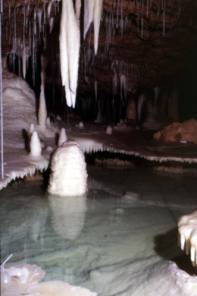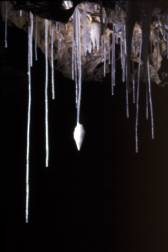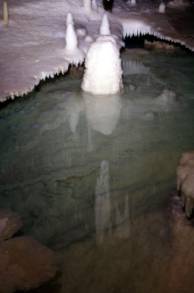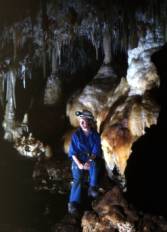South West of
Western Australia
Click on the photos to enlarge them More Photographs by Lloyd Robinson
Underway Pre and Post-Conference Caving Trips 6 and Photos by Bob Kershaw
 These
trips were organised by Jay Anderson the incumbent WASG President and now
Senior Vice-President of ASF. Thank you Jay for all your mind bending work
preparing who went where during these trips.
These
trips were organised by Jay Anderson the incumbent WASG President and now
Senior Vice-President of ASF. Thank you Jay for all your mind bending work
preparing who went where during these trips.
26th December 2002
Those who participated at Yanchep, about 80kms north of Perth, were able to stay in a “luxurious” cottage for the two nights. Yes, hot water, showers and washing machines!
Jay and Ross Anderson (WASG) Rob ? [Woggie] WASG, and Kay (from NZ and WASG), Iain McCulloch (NUCC) and me.
At Yanchep the caves were formed in the Late Pleistocene from Aeolian Calcarenite. They are small and crumbly as the water has dissolved the ‘roof’ of these porous limestone areas and it has collapsed forming the “larger” caverns.
In the afternoon we entered YN-16, Yanchep Cave - a small crumbly cave. Then YN-2. Yonderup Cave which has wooden and concrete pylons to hold up the roof! Lastly we entered YN-12, Mambibby Cave a through trip crawling in low roof sections and over damp peat floors.
27th December
 Four more
caves in close proximity to the cottage. YN-13, Loch Overflow. YN-? Jackhammer.
Four more
caves in close proximity to the cottage. YN-13, Loch Overflow. YN-? Jackhammer.
YN-36, Car Park Cave and YN-151- Serindip an expansive
collapsed section with formation and as Lex Bastian found a “stalagtight”. A
stalagtite had fallen and cemented itself to a stalagmite at a 90 degree angle.
Then the floor was eroded and the newly  cemented
speleothem became a “stalagtight”!!!
cemented
speleothem became a “stalagtight”!!!
28th December
We drove further north to Jurien, about 30kms North of the Pinnacles, also formed in the Late Pleistocene from Aeolian Calcarenite, and arrived about 1.30pm. After removing the mammoth amount of gear from the Forester and re-configuring the seating, Jay, Ross Iain and I drove to E-1,2,3 Stockyards. This is a series of 3 tunnels and the last is truly cave like. A streamway passes through all 3 tunnels and has created this phenomena. Above each entrance is s series of natural open air beehives, high amongst the limestone.
Later we drove to E-9, AIYENNU Cave (ANU Cave) first
recorded by Joe Jennings in 1964. The entrance is surrounded by bees too! A
15m-20m abseil into the cave greets the abseiler with over 100 “entrances” as
one looks up to the roof. The cave has been eroded and the limestone cap rock
has the remains of 100 solution holes. Photographs at different times of the
day create varying and wonderful images - not that I took any!!! A prussick out
- my first in many years gave me a chance to count the holes during rest  stops. We
arrived back at the APEX campground at 8.50pm and just in time to purchase fish
and chips for our evening meal.
stops. We
arrived back at the APEX campground at 8.50pm and just in time to purchase fish
and chips for our evening meal.
29th December
We were joined by Lance Hoey and Barbara from CEGSA and headed to J-7 (Old River Cave).
We let the tyres on the Forester down to 15 psi and cruised over the sandy tack, mowing down the vegetation in the middle of the tack and scrapping the side of the car with recently burnt vegetation - oh for a black coloured Forester!
The entrance area is covered in brown ticks and bees.
Fortunately, the ticks don’t burrow into the skin as soon as the eastern states
black ticks do. Thank goodness, because many ticks later....
This cave has a small slot to abseil down a 10m pitch. The cave is very hot and humid and easily saps the strength and willingness to cave over collapse after collapse (just like a mini Mullamullang) to then abseil down another 20m pitch and a quick scramble to river level. Here we measured the water depth and velocity in a continuing experiment set up many years ago. Ross and Jay went for a saunter down the river looking for organisms while Iain and I had a quick nap! We exited the cave at 5pm after entering it at 10am. We returned to camp to find Jodie and Michael Rutledge from NHVSS had arrived for a 2nd honeymoon in the area. A relaxing night with a few drams of wine and port and good company.....what more can a caver ask for!!!
30th December
Jay, Ross, Lance, Barbara and I headed for J-2 (Drovers Cave)
in the morning to undertake some track marking in consultation with a local  CALM
ranger and to look at the excellent speleothems. Back to camp for lunch and
Ross decided to give the wind surfer a go in the increasing breeze. The rest of
us headed to view 4 other caves but the steel gates had become rusted shut in 3
of the 4 caves. The initial fitting of the gates must have had mm to spare but
over time and rain the sides had all but rusted shut. We eventually entered
SH-7 (Thousand Man Cave) to be confronted with thousands of stalagtites and
mites. What a great cave!
CALM
ranger and to look at the excellent speleothems. Back to camp for lunch and
Ross decided to give the wind surfer a go in the increasing breeze. The rest of
us headed to view 4 other caves but the steel gates had become rusted shut in 3
of the 4 caves. The initial fitting of the gates must have had mm to spare but
over time and rain the sides had all but rusted shut. We eventually entered
SH-7 (Thousand Man Cave) to be confronted with thousands of stalagtites and
mites. What a great cave!
We arrived home about 7pm and pizzas ruled the menu as we re-packed out cars ready for an early return to Perth the next morning.
31st
I returned to Perth and met up with Fran Head and Ian Coll
ette who kindly allowed Myself and Lance and Barbara to stay at their house for a couple of days R&R over New Years Eve and Day.
2nd to 7th January 2003
The Conference at Bunbury was excellent.
A team of 4 from NUCC, CSS and ISS won the speleosports and
Chris Bradley and I came third in the surveying  competition. A few LED lights were the prizes and now adorn
our helmets.
competition. A few LED lights were the prizes and now adorn
our helmets.
5th January
 This was
a field trip were all attendees hoped on buses and headed for the tourist caves
of the SW of WA. YA-1 (Yallingup now called Ngilgi Cave) first discovered in
1899 by a John Dawson. Then onto the Caveworks display and a trip into Lake
Cave (WI-30) and then a self-guided tour through WI-21 (Giants Cave) before
returning home at 8pm.
This was
a field trip were all attendees hoped on buses and headed for the tourist caves
of the SW of WA. YA-1 (Yallingup now called Ngilgi Cave) first discovered in
1899 by a John Dawson. Then onto the Caveworks display and a trip into Lake
Cave (WI-30) and then a self-guided tour through WI-21 (Giants Cave) before
returning home at 8pm.
8th January
After the conference we had an early start to begin caving
at 1030am in the Witchcliffe area- several hours drive south of Perth near
Margaret River. The first was WI-13 (Golgotha Cave) with Gary Smith from NHVSS,
Arthur Clarke from TC, Robyn Weckert from MUCG and Iain McColloch led by Ross
Anderson. This was an old tourist cave with a Heritage listed  wooden
gate at the entrance. Then onto WI-9 ( Kudjal Yolgah Cave) and later in the
afternoon into WI-59 (Mill Cave) with Miles Pearce from VSA. Upon returning to camp we immediately headed
to AU-11 (Moondyne Cave) for a guided tour in the old tourist cave adjacent to
Augusta Jewel cave. We returned to the WASG hut at 10pm for a very late toasted
cheese and ham sandwich before turning in.
wooden
gate at the entrance. Then onto WI-9 ( Kudjal Yolgah Cave) and later in the
afternoon into WI-59 (Mill Cave) with Miles Pearce from VSA. Upon returning to camp we immediately headed
to AU-11 (Moondyne Cave) for a guided tour in the old tourist cave adjacent to
Augusta Jewel cave. We returned to the WASG hut at 10pm for a very late toasted
cheese and ham sandwich before turning in.
9th January
A trip led by Michael Bradley from SRGWA into the Xmas Star Extension of WI-62 (Crystal Cave) to undertake some serious photography with David Wools-Cobb from Northern Caveneers (NC) and Rob Squibb (NC). After the tight squeeze that was gated we had to de-trog and undertake the photography in our shorts and t-shirts - no shoes. This is a pristine area of WA and the Conference attendees used up the yearly permits to the cave in the space of 5 days. This is where I wish my ashes to be scattered but the WA cavers didn’t like the idea!
We exited about 4.30 and had a quick wash and dinner before heading to the Augusta Jewel Cave to hear Lloyd give about 50 attendees and cave guides an historical dissertation about how he and his colleagues discovered the cave in 1958 and the subsequent construction in this cave to become a significant tourist attraction. Pity there is no water in the lake now! Two and a half hours later...... The guides can now only give two tours each in a day due to the high carbon Dioxide levels experienced in the cave and the tours only last about an hour.
10th January
Into AU-14 (Easter Cave) with a 12m abseil down a solution tube that was blowing outward for a full day of photographing with David, Robyn and led by Michael to the “Lemon”. A great deal to straws and other eroded features in the cave. We ventured to Augusta for a late afternoon tea and fuel and new batteries for the fire fly remote flash connector before returning to the hut.
11th January
A morning trip into AU-16 (Labyrinth Cave) with David, Rob and Jessica Wools- Cobb for some exquisite photography of a tree root growing through and out a straws among other features such as helictites and shawls. It certainly lives up to it’s name.
12th January
A morning trip returning to WI-62 (Crystal Cave) but into the Protemnden Section with Robyn and David led by Michael. More detrogging to take photos of some crystal pendulites and a drip falling into a small tree root stalagmite.
I would
like to thank all those involved for the fantastic work that went into the
conference and pre and post-caving trips.
After
caving at the Margaret River/Augusta area I now appreciate the trouble that
clubs in the West go to, to protect the caves and formations that exist in the
caving regions in WA. It would be wonderful to go back 150 years in the east
and start over, but unfortunately we cannot do this, so the caves in the east
will in most cases continue to be abused by the uninformed.
A couple of days later I commenced driving about 1000kms for 12 hours per day to arrive home at 6pm 4 days after leaving a great caving area in Australia and the hospitality of the Western Australian caving Clubs.







